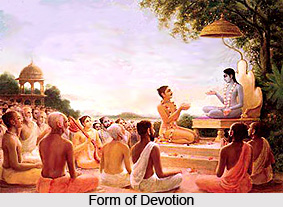 Bhakti is supreme love for God. It is the spontaneous out-pouring of Prem towards the Beloved. It is pure, unselfish, divine love or Suddha Prem. There is not a bit of bargaining or expectation of anything here. This higher feeling is indescribable in words. It has to be sincerely experienced by the devotee. Bhakti is a sacred, higher emotion with sublime sentiments that unites the devotees with the Lord.
Bhakti is supreme love for God. It is the spontaneous out-pouring of Prem towards the Beloved. It is pure, unselfish, divine love or Suddha Prem. There is not a bit of bargaining or expectation of anything here. This higher feeling is indescribable in words. It has to be sincerely experienced by the devotee. Bhakti is a sacred, higher emotion with sublime sentiments that unites the devotees with the Lord.
For practicing Bhakti yoga, apart from the mantras, the main point to be considered is the worship of God through Pratika or images. Worshipping god through Pratikas is joining the mind with devotion to a level that is not the Brahman, but instead taking it to be Brahman. A bhakta has to worship the mind, which is the internal Pratika or the Akasha as the Brahman with regard to the Devas, as the external Pratika; however both have to be worshipped as substitutes of God.
Worshipping god alone refers to, as Bhakti and the worship of other Devas or Pratikas cannot be termed as bhakti. The various kinds of worship of the various Devas though is important for rituals and for the celestial enjoyment for the worshipper, it does not give rise to Bhakti nor can it lead to Mukti. Any gods or other beings worshipped in and for themselves, such worship is only a ritualistic Karma; and as a science it gives us only the fruit belonging to that particular science, but when the Devas or any other beings are looked upon as Brahman and worshipped, the result obtained is the same as by the worshipping God.
The same ideas apply to the worship of the Pratimas as to that of the Pratikas that is to say, if the image stands for a god or a saint, the worship is not the result of Bhakti, and does not lead to liberation; but if it stands for the one God, the worship thereof will bring both Bhakti and Mukti. In a form of image-worship, the allegiance of the soul instead of being given to Ishvara, they actually worship the images, or graves, temples, tombs that are the real worship; this kind of worship is neither sinful nor wicked. This worship is considered as a ritual - Karma, and the worshippers thereof must and will get the fruit thereof.




















